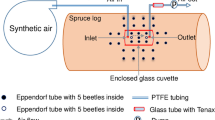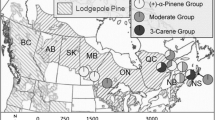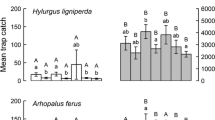Abstract
The bark beetles Ips pini, I. perroti, and I. grandicollis are sympatric in pine forests of the north-central United States. They share the same limited phloem resource and often coexist within the same host trees. We tested whether phloem resources are partitioned in time and space by measuring spatial and seasonal colonization of logs. Differences among species in flight phenology, development time, voltinism, and spatial colonization patterns within logs reduce, but do not eliminate, species overlap. The bark beetle species share predation by Thanasimus dubius (Cleridae) and Platysoma cylindrica (Histeridae), which exploit pheromone signals for prey location. We employed pheromone traps to test for chemical communication among bark beetle species. Heterospecific signals tend to be deterrents when they are added to conspecific signals but attractants when they are alone, indicating that the communication system can both reduce and increase species overlap in resource use depending upon relative abundance of the species. Deterrence by heterospecific signals is probably a result of selection for minimizing interspecific competition. However, individuals may sometimes benefit from joining aggregations of other species because of (1) predator swamping, (2) improved success in attacking live trees, and (3) location of suitable, recently dead, trees. These benefits should be greatest for males (which locate and colonize host trees before signalling females) and indeed males tended to be more attracted than females by heterospecific signals. Shared resources, shared predators, and heterospecific pheromone communication all contribute to species interactions in this guild of bark beetles, but predicting whether the removal of one species will tend to increase or decrease the abundance of remaining species remains difficult. Species interactions are likely conditional and coexistence is probably promoted by benefits to rare species of multispecies associations.
Similar content being viewed by others
Author information
Authors and Affiliations
Additional information
Electronic Publication
Rights and permissions
About this article
Cite this article
Ayres, B.D., Ayres, M.P., Abrahamson, M.D. et al. Resource partitioning and overlap in three sympatric species of Ips bark beetles (Coleoptera: Scolytidae). Oecologia 128, 443–453 (2001). https://doi.org/10.1007/s004420100665
Received:
Accepted:
Published:
Issue Date:
DOI: https://doi.org/10.1007/s004420100665




